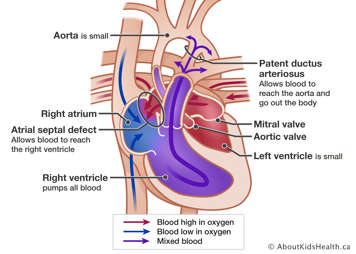With hypoplastic left heart syndrome (HLHS), the left side of the heart is underdeveloped. Blood coming back to the heart from the lungs has to go through an atrial septal defect, and blood reaches the aorta through a patent ductus arteriosus.
The two images below compare a normal heart to a heart with HLHS.


HLHS is the most common of the severe congenital heart defects. It accounts for 7% to 9% of all heart defects diagnosed within the first year of life.
What are the symptoms of hypoplastic left heart syndrome?
Symptoms usually become noticeable soon after birth when the ductus ateriosus closes. They include cyanosis, poor colour, rapid difficult breathing, and trouble eating. The condition can be fatal if left untreated. An electrocardiogram and an echocardiogram are done to make a diagnosis.
How is hypoplastic left heart syndrome treated?
At first, a drug like prostaglandin will be given to keep the ductus arteriosus open to improve blood flow. HLHS cannot be corrected, but reconstructive heart surgery can usually help the baby live and grow. Three operations are done in stages, to help the body and lungs adjust to the altered blood flow. They include:
- the Norwood procedure
- the bidirectional cavopulmonary shunt (BCPS)
- the Fontan operation
The goal is to help the right ventricle pump only oxygenated blood to the body and prevent it from mixing with de-oxygenated blood.
Heart transplantation may also be considered as an alternative surgical option.
What is the long-term outlook for children with hypoplastic left heart syndrome?
It is estimated that 75% of children with HLHS survive after the first stage of the reconstruction. Survival improves with each subsequent surgical procedure.